This page is intended to provide a starting point for how plainchant can be practically used in an ordinary parish setting. It provides notes on what the church says, how to read the notation and some things to consider – recognising that every parish is different. It is organised with sections on:
1. What the Church Says
Gregorian chant should be given pride of place
Actual participation of the faithful
There is a preference for chant and its use in ordinary parishes
2. How to Read Chant
Modern Notation Versus Gregorian Notation
The Clefs, the Scale, the Accidental
Barlines and Moving Between Lines of Notation
The Neumes of French Square Notation
The Rhythm and Shape of the Chant
The Psalmtones
3 Using Chant in a Parish Setting
English Vs Latin
Accompanied or Unaccompanied
Choosing the First Note
The Role of the Cantor and Singing Antiphonally
Chant as Part of the Mass
Chant Throughout the Year
4 Example Resources
Books / introduction
Music resources
Websites / forums
Golden Rules
Before you begin, keep these golden rules in mind at all times when singing plainchant:
Never accent the end of a phrase Hold on to the last note only as long as it is written Sing the chant at the speed you would speak it Breathe at the (full and half) bar lines Listen to the other voices (and watch the conductor)
1. What the Church Says
Gregorian chant should be given pride of place. “The musical tradition of the universal Church is a treasure of inestimable value … it forms an integral part of the solemn liturgy … [to] the glory of God and the sanctification of the faithful.” (SC 112) The “treasury of music [is to be] preserved and cultivated with great care.” (SC 114) “Therefore, other things being equal it [Gregorian chant] should be given pride of place in liturgical ceremonies.” (SC 116).
Participatio actuosa (‘actual participation’) of the faithful. “All the faithful should be led to that full, conscious, and active participation in liturgical celebrations which is demanded by the very nature of the liturgy” (SC 19) “and at the proper time a reverent silence should be observed.” (SC 30) The treasury of sacred music demands that “choirs must be assiduously developed, especially in cathedral churches.” (SC 114) “Actuosa therefore should be understood as implying an involved and direct entering into the action and the spirit of the liturgy, rather than merely outward activity during it.” (GP 2) “Music that should be sung in the liturgy may therefore rightly include both congregational and choral settings, equally to foster true participatio actuosa.”
There is a preference for chant and its use in ordinary parishes. For the rite of Mass General Introduction to the Roman Missal (GIRM) discusses music that is permitted at each point, in order of preference. For example, “in the dioceses of England and Wales the Entrance Chant may be chosen from among the following: the antiphon with its psalm from the Graduale Romanum or the Graduale Simplex, or another chant that is suited to the sacred action, the day, the time of year, and whose text has been approved by the Conference of Bishops of England and Wales.” (GIRM 48) Although it is noted that chant settings of the Graduale Romanum “while they represent the highest form of liturgical chant available at this point … [they] generally lie beyond the capacity of the ordinary parish.” (GP 4) So, in turn, “it is desirable that an edition [of Gregorian chant resources] should be prepared containing simpler melodies, for use in smaller churches” (SC 117) that would be “suitable for ordinary parish choirs, cantors, and congregations.” (GP 4)
- (SC) The Constitution on the Sacred Liturgy of the Second Vatican Council, Sacrosanctum Concilium, 4 December 1963, (tr. A. Flannery, 1975)
- (GP) Graduale Parvum 2018, John Henry Newman Institute of Liturgical Music Association for Latin Liturgy.
- (GIRM) General Introduction to the Roman Missal, The Roman Missal, ICEL/CTS 2010.
2. How to Read Chant
2.1 Modern Notation Versus Gregorian Notation
French Square Notation (Gregorian Notation) is designed specifically for singers and has evolved over many centuries. Whilst modern notation has a level of accessibility for singers with less exposure to chant notated on the four line stave, it does not show all the nuances of how the chant is to be sung, and for some elements there is no modern equivalent (e.g. Quilisma, Episima). It is worth investing time in learning the notation, although modern notation equivalents can be of use where this is a knowledge gap among the singers or where an accompanist requires this. Whilst resources exist in both forms, it is the French Square Notation that is the standard for music in this style. (Note that the French Square Notation is not written in any particular key.)
2.2 The Clefs, the Scale, the Accidental
The intervals between notes in all Gregorian chant are the same as a Diatonic scale.
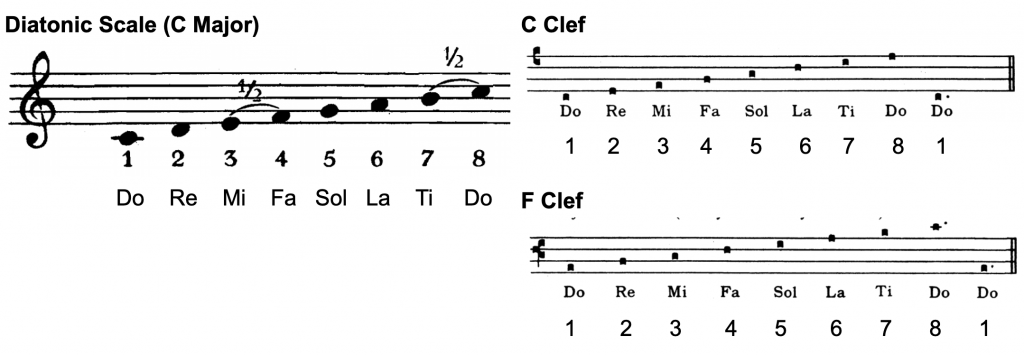
The four line stave simply shows the intervals between the notes. The line in the centre of the ‘C clef’ is always Do, or 1, or the root of the Diatonic scale. The line in the centre of the ‘F clef’ is always Fa, 4, or the fourth in a Diatonic scale. It’s easiest to think about the intervals in C major, although the chant can be sung in any key (and the chants may be in different modes, which are often determined by their endings). Finding Do and Fa identify where the semitone intervals are in the scale.
There is only accidental. Ti (7th of the scale) and only Ti can be flattened by a semitone, denoted in the same way as in modern notation (♭). It usually applies for the remainder of the syllable being sung, or until the next barline, or until there is a natural sign (♮), whichever comes first.
2.3 Barlines and Moving Between Lines of Notation
There are four types of barline:
- The quarter barline is intended more as a collection point within the phrase of chant. The chant continues at pace and without a pause through the quarter barline. It may be necessary to breathe here depending on the length of the phrase. If a breath is required, shorten the preceding note/neume.
- The half barline identifies a break is a break in a phrase of chant – take a breath if needed.
- The full barline is a definite break between phrases. Here there should be a rest of about 2 pulses between the phrases (unless the notation indicates otherwise).
- The double barline indicates the end of a section (or change of choir).
In addition there is one very helpful marking (the Custos) at the end of each line that indicates the pitch of the note that the next line starts on. This allows the two lines to join together seamlessly and for those who are to sing it to know what the interval is between the end of one neume and the start of the next.
2.4 The Neumes of French Square Notation
Neumes are the (groups of) ‘notes’ on the stave. These can become compound and built into intricate combinations. There is a basic pulse that runs through the chant. It is a single measure that is always of equal length and that cannot be divided. It is from this that all elements of the chant are built, and in modern notation it could be considered as equivalent of an eighth note or quaver ( ♪ ). Here are a few neumes to get us started in our workshop, with a few simplifications.
Neumes that are a single pulse in length:
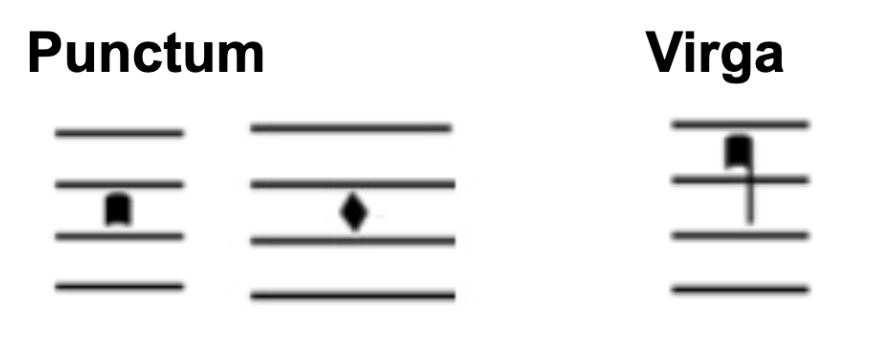
Neumes that combine multiple pulses together. Read these from left to right. Where there is a vertical line is on the right, the bottom note is sung first. If two measures are on the same line these can be added together to make a longer note.


Neumes where the pulse is lengthened. A dot (Mora) after a measure will double its length. A horizontal line (Episima) under or over a (group of) measure(s) indicates to lean on these and make them longer.

Neumes that are sung in a special way. These will catch you out if you don’t have your glasses on:

2.5 The Rhythm and Shape of the Chant
Each of the neumes indicate how the chant is to be sung around its basic, unwavering pulse. The rhythm of the chant is more its intensity of sound, where the emphases are placed and how it is lifted off the page. (Groups of) neumes within the chant form basic rhythmic units each with a start/rise/impulse (Arsis) and end/repose/fall (Thesis). These overlap throughout phrases and are bit like waves crashing on a beach. If there’s a large wave already there then the swell of the two waves add together and it becomes more intense. If another wave arrives as the previous one is receding, then it overtakes it and there is renewed energy and the wave continues. When the last wave flows back to the sea, that is the phrase in the chant gently fading away. The rhythm is that of the crests of the waves.

The basic rhythmic units may typically be every (group of) 2 or 3 neumes, and it will be the shape of the rhythm that a conductor will typically communicate to the schola. The notation has helpful markings (the Ictus) to identify where one unit finishes and the next begins, although this is not always notated if the shape of the neumes in the chant already hint towards it. The following guide (reproduced from http://www.ccwatershed.org/media/pdfs/12/07/06/17-09-09_0.pdf):
Additionally, the tónic accénts in the text (such as on María Virgíne) also help shape the sound, indicating the important vowels and emphasis in the rhythm. These will often coincide with additional emphasis, or another wave crashing on the beach.
2.6 The Psalmtones
There are eight plainchant psalmtones, with a variety of endings, and an addendum that includes Tonus Peregrinus. The tones are numbered according the their mode (1 – 8) and their ending is given as the letter of the note they would finish on if the tone was sung in C major. The variety of endings are included so that the final note of the psalmtone can be the same as the first note of the antiphon which follows. Each of the psalmtones follow a set formula that includes:
- an intonation, that has several notes to allow the cantor to introduce the mode.
- the tenor, which is the reciting note on which the chant is sung.
- (a flex, for when there is a lot of text to be sung on a single line and an early break is needed.)
- the mediant, which is the end of the first line.
- a return to the tenor, which is the reciting note upon which the chant is sung.
- the termination, which is the end of the chant (and may be one of multiple options).
Each of the hollow notes are optional in the chant, the text is sung ignoring the commas in the punctuation, and the áccents in the psálm text often álígn with the áccents in the psálmtone. (This is more readily achieved in Latin than in English. In English accented last syllables appear more frequently.) For Tone 8:
Which, without the flex, could become the following for VIII G. The psalm text is pointed so that the bold syllable aligns with the accent in the psalmtone. The psalmtone may move one or more notes before the accent, and these are shown in italics.
When the pointing is added to the text alone, it would appear as in the following extract from Psalm 4:
Psalmus 4 Invocántem exáudi me, Deus iustítiae meae; In tribulatióne dilatásti mihi. Miserére mei Et exáudi oratiónem meam. Fílii hóminum, úsquequo gravi corde? Ut quit dilígitis vanitátem et quaéritis mendácium? Et scitóte quóniam mirificávit Dóminus sanctum súum; Dóminus exáudiet, cum clamávero adéum.
Psalm 4 I cálled, the Gód of jústice gave me ánswer; from ánguish you reléased me, have mércy and héar me! Children of mán, how lóng will my glóry be dishónoured, Will you lóve what is fútile and séek what is fálse? Knów that the Lórd works wónders for his fáithful one; The Lórd will héar me whenéver I cáll him.
The full set of psalmtones are summarised well by MusicaSacra (reproduced from https://media.musicasacra.com/pdf/tones.pdf)
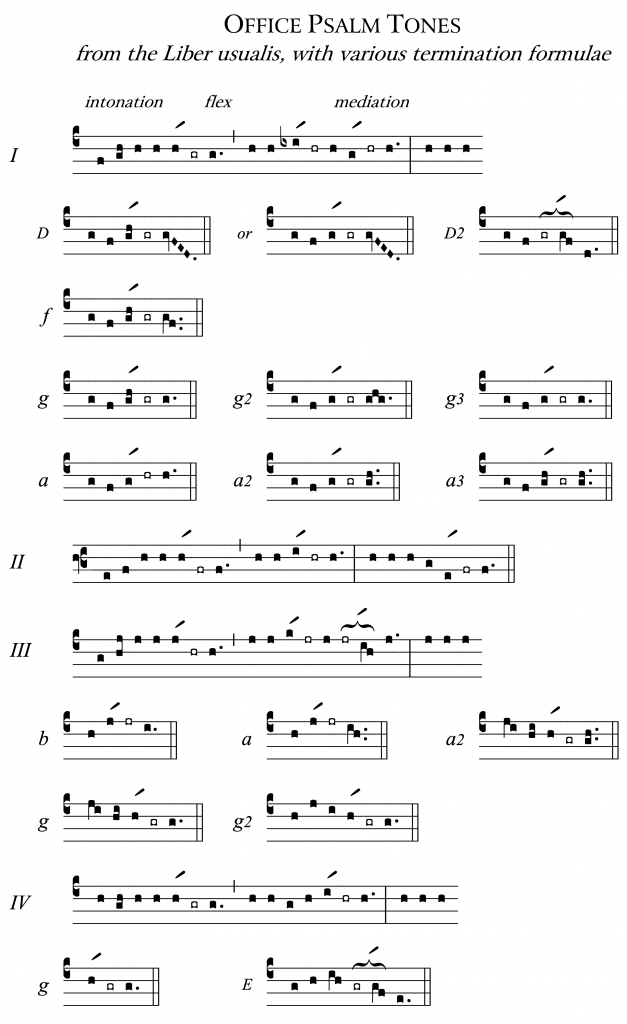
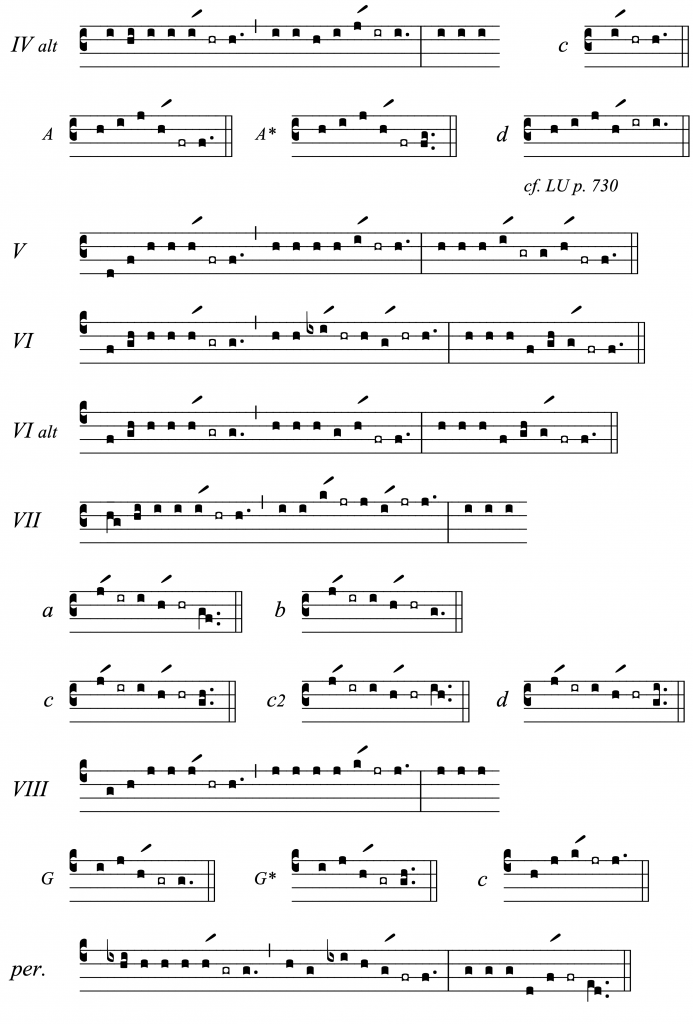
3 Using Chant in a Parish Setting
3.1 English Vs Latin
The universal language of the Church is Latin and much of the chant repertoire that has been built over many many centuries exists in this form. Some chants are repurposed in the vernacular (with varying degrees of success e.g. plainchant Mass settings), and some (often simpler) chants have been written for the vernacular (e.g. English Proper Chants), many of which are true to the character of the original Latin counterparts for the same text. The Extraordinary Form requires Latin exclusively and the Ordinary Form permits the use of both Latin and the Vernacular.
For parish use, the choice of language may be influenced by issues such as:
- the culture of the parish (whether the use of Latin is the norm or the exception).
- the part of the liturgy during which it is used (e.g. Communion proper, Vs Gloria, Vs the Office).
- whether translations are/can be provided (e.g. if the text sung is not from the Ordinary).
- the musical and liturgical experience of those who are to sing it (i.e. familiarity with Latin, the complexity or musical quality of the setting in the chosen language).
- whether the congregation are intended to participate in the singing.
- access to resources.
Comparable settings exist for both languages. As an example, the Introit for the Seventeenth Sunday in Ordinary Time (Reproduced from the Graduale Parvum 2018, John Henry Newman Institute of Liturgical Music Association for Latin Liturgy. http://www.ccwatershed.org/media/pdfs/13/05/27/08-11-14_0.pdf).
3.2 Accompanied or Unaccompanied
All chant can be sung unaccompanied. Whilst some debate may exist regarding the authenticity, accompaniment can be used to add texture and support for singers. The decision to accompany may be driven by the acoustics of the building, the musical experience (and ability to keep pitch) of those who are to sing it, and also whether it is intended for congregational singing.
A range of resources exist in modern notation for accompanists, such as the Solemnes editions of the Liber Usualis, Liber Cantualis, Kyriale and Graduale Romanum. Websites, such as ccwatershed and musicasacra, archive previous editions of many chant resources in modern notation. This may on occasion require the accompanist to improvise a harmonisation if that chant is less commonly recited. Simple accompaniment is most effective, built entirely from notes in the Diatonic scale.
The choice of instrument for accompanying chant is most certainly leans towards the use of the organ. The continuous sound and versatility of the instrument lends itself ideally to a smooth continuo under the chant. The accompaniment should ideally never overshadow the melody of the chant (although some arrangements, such as those of Mgr. Revert at Notre Dame de Paris quite clearly bring this to life when sung in alternatum with the Great Organ). Often one or two flute stops are sufficient for most chant that is to be sung by a schola. For chant that is congregational, often a greater Diapason chorus can be employed to support and encourage the main assembly, although this often overshadows much of the shaping of the chant that the schola might achieve, as it is for a different purpose and participants. Organ permitting, it is often worth exploring some of the 4’ stops an octave down and likewise playing the melody (or variation) as a solo an octave higher on an 8’ stop.
3.3 Choosing the First Note
Chant notation uses four lines as the vocal range of the average piece to be sung will fit comfortably within four lines. Often it is the clef that moves to change how the piece is to be sung within the stave. Comfortable singing range for most singers falls between C and the D an octave higher. The chant should be placed so that it sits comfortably within the middle of this. Look for the highest and lowest parts of the chant first and work backwards from this.
The choice of pitch may also vary according to the time of day (higher in the afternoon as voices are warmer) and the location where the chant is to be sung (higher notes will be more readily heard in challenging acoustics) and the vocal range of those who are to sing the chant (altos and basses are most vocal on this matter).
3.4 The Role of the Cantor and Singing Antiphonally
Where chant is to be sung unaccompanied or it is to be introduced, the part of cantor(s) is marked up until the * in the text. For example the celebrant may intone the Gloria or a cantor intone the Agnus Dei.
Some chant may be sung as a responsory, where it makes particular sense for a cantor to intone a simple antiphon or phrase, for instance where the assembly is to respond, such as in the Litany of Saints, or responses between psalm verses during the Introit.
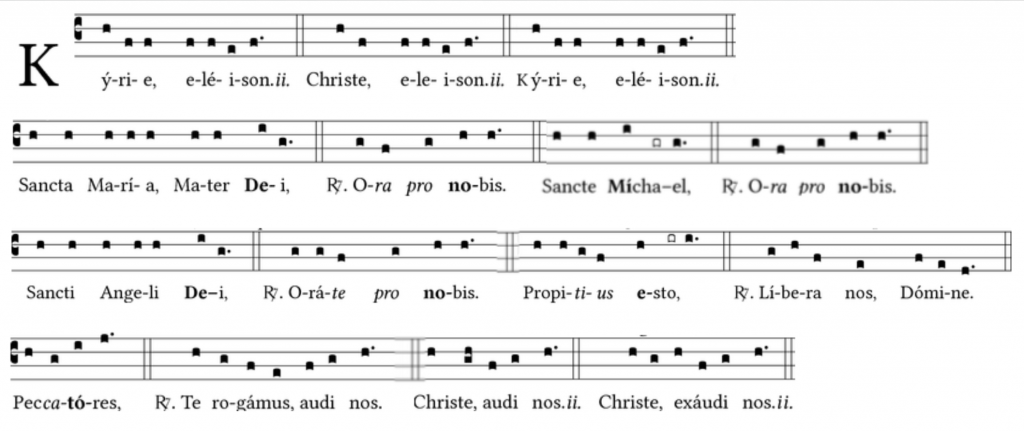
Some chant is designed as dialogue between the Celebrant/Lector and choir/assembly, such as the Preface Dialogue or Mystery of Faith.
Chant verses also may be sung by (group of) cantors such in the verses of the Introit, or in alternatum during recitation of the Divine Office, with one side of the Nave responding to the other. (Refer to Page 8 for example).
3.5 Chant as Part of the Mass
The Church prescribes text for all sung aspects of the Mass. (The prescribed text does not include hymns for the rite of Mass, however hymns can be used as a substitute for specific texts, as is permitted under General Instruction on the Roman Missal.)
Chant and Latin settings exist for everything that is to be sung, in addition to a growing body of simpler Gregorian Chant in English. Opportunities for incorporating chant into the rite of Mass may include:
- Dialogues with the Celebrant/Lector (Penitential Rite, Gospel, Preface dialogue, Mysterium etc.).
- The Mass Ordinary (Kyrie, Gloria, Credo, Sanctus etc.).
- The Mass Proper (Introit, Gradual/Psalm, Alleluia, Offertory, Communion etc.).
- Elements sung in accordance with local custom, but that are outside the order of Mass (e.g. Marian Antiphon during the Prayers of Intercession).
- Additional suitable music at appropriate points (e.g. as a Communion reflection, when the Proper has already been sung).
- In places where GIRM indicates substitution is permitted as part of the formula, e.g. “… or another chant that is suited to the sacred action, the day, the time of year, and whose text has been approved by the Conference of Bishops of England and Wales.” (GIRM 48)
3.6 Chant Throughout the Year
A well established repertoire of chant exists for the whole liturgical year. In addition to the collections of Propers (simple and florid) and Ordinary for each celebration of Mass, there are pieces that would fit with particular seasons, and that would be a good core repertoire for building up the presence of chant in the liturgy, if this is not part of the custom of a parish. The Liber Cantualis (Solesmes) is an excellent starting anthology for this, with inclusion of its Cantus Varii in addition to selected highlights from the Kyriale. Some ideas (far from exhaustive!):
Advent and Christmas
Creator alme siderum
Rorate caeli
Veni, veni Emmanuel
Great ‘O’ antiphons
Resonet in laudibus
Puer natus in Bethlehem
Lent, Passiontide, the Triduum
Attende Domine
Hosanna filio David
Ubi caritas
Pange lingua
Crux fidelis
Eastertide and Pentecost
Litany of saints
Victimae paschali laudes
Vidi aquam
Surrexit Dominus
Veni Creator
Veni Sancte Spiritus
Other
Lumen ad revelationem
Christus vincit
Te Deum
Blessed Sacrament
Ave verum
Adoro te
Ecce panis
O salutaris hostia
Pange lingua
Tantum ergo
Virgin Mary
Alma Redemptoris (Advent – 2nd Feb)
Ave Regina caelorum (2nd Feb – Easter)
Regina caeli (Easter – Pentecost)
Salve Regina (Pentecost – Advent)
Salve Mater
Ave Maria
Concordati laetitia
The Hours
Benedictus
Magnificat
Nunc dimittis
Te lucis ante terminum
In manus tuas
For the Dead
Requiem aeternam
Lux aeterna
4 Example Resources
* Resources with an asterisk are intended for groups in smaller parishes.
Books/Introduction to Chant
- * Plainchant for Everyone (Mary Berry) (RSCM, 1979) [Book]
- * Introduction to Gregorian Chant, with a few videos (ccwatershed) [Webpage]
- Guide to singing chant (ccwatershed) [Book extract as pdf]
- Bibliography of principal chant books (Beaufort) [Webpage]
- The Rhythm of Plainsong (musicasacra) [Book as pdf]
Propers (English/Latin)
- * Graduale Simplex (Solesmes) [Book]
- * By Flowing Waters (American English version of the Graduale Simplex) [Book]
- * Graduale Parvum (Guy Nicholls) [Book]
- * English Proper Chants (John Ainslie) [Book]
- * Simple English Propers (Adam Bartlett) [Webpage, Book]
- Graduale Romanum (Solesmes) [Book]
- Liber Usualis (Solesmes) [Book]
Ordinary
- * Liber Cantualis (for selected masses) (Solesmes) [Book]
- * Missal chant accompaniment [pdf]
- Kyriale (Solesmes) [Book]
General
- * Liber Cantualis (Kyriale, plus a chant selection) (Solesmes) [Book]
- GregoBase (Online typesets of many common chants) [Online Resource]
- Bloomf (Online Notation editing and automatic selection/setting of Mass texts) [Online Resource]
Cheat’s Versions of Chant Books and Online Copies of Established Chant Books
- * Graduale Simplex (Gregorian) [pdf]
- * Graduale Parvum (Modern Notation) [pdf]
- * Simple English Propers (Gregorian) [pdf]
- * Parish Book of Chant (Gregorian) [pdf]
- Liber Usualis (Gregorian) [pdf]
- Liber Usualis (Modern Notation) [pdf]
- Index of many of the main editions of chant books (Gregorian) [Website]
Websites and Forums
- Corpus Christi Watershed [Website]
- ChantCafe [Website]
- CanticaNova [Website]
- MusicaSacra [Website]
- Blessed John Henry Newman Institute of Liturgical Music [Website]
- Liturgy Office of England and Wales Resources [Website]
- Gregorian Chant Hymns [Website]